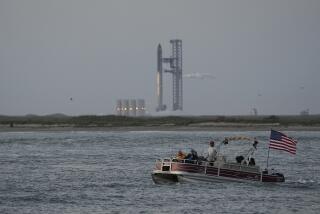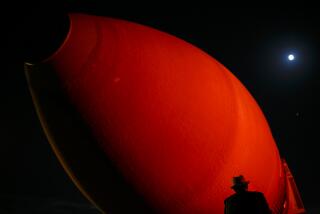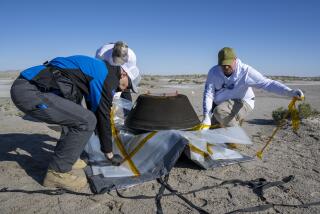Shuttle Aloft, Sends Galileo on 6-Year Voyage to Jupiter
KENNEDY SPACE CENTER, Fla. — The shuttle Atlantis roared into space Wednesday on the first leg of the most ambitious planetary mission to date.
Galileo, the most sophisticated unmanned spacecraft ever built, was released from the shuttle’s cargo bay six hours after the 9:53 a.m. PDT launching and is finally on its way to Jupiter. It was a launching that some scientists were beginning to think they might never see.
The spectacular liftoff, which had been delayed several times, marked both a beginning and an end.
It marked the end of years of frustration for scientists and engineers who built the Galileo and then watched it narrowly escape the scrap heap several times.
“It was definitely a special day for them,” launch director Robert Sieck said.
“It was worth the wait,” said Richard Young of NASA’s Ames Research Center in Mountain View, Calif., one of the principal scientists on the project. “It was fantastic.”
Atlantis commander Donald E. Williams, 47, could not have agreed more. “We’re happy to be here,” he said as the shuttle orbited 184 miles above Earth.
And the launching signaled the beginning of what promises to be a spectacular journey through space. It will take six years for Galileo to reach Jupiter, the largest planet in the solar system; but, along the way, the spacecraft will tour the inner solar system and its camera will even offer humans their first view of Earth as it would be seen by visitors from outer space.
For a while, NASA officials considered scrapping the $1.4-billion project as the space agency struggled to rebuild after the Challenger explosion. Scientists who had invested much of their careers in the project held their breaths as NASA reevaluated the mission.
Galileo had been designed to be put into low Earth orbit by the shuttle and then use a liquid-fueled engine to blast itself on to Jupiter. But, because of concerns about safety after the Challenger disaster, NASA decided to prohibit liquid fuel in the shuttle’s cargo bay, leaving Galileo with a great itinerary but no way to travel.
Galileo was saved when engineers at the Jet Propulsion Laboratory came up with a way of getting the spacecraft to Jupiter without using liquid fuel. It could be done, they concluded, by using a safer solid rocket motor to push Galileo beyond Earth’s grasp.
The solid rocket is not powerful enough to give Galileo the speed it will need to reach the outer solar system, so Galileo will have to take the scenic back roads to Jupiter.
After Galileo was released from the shuttle’s cargo bay, it used its rocket to slow itself down as it sped around Earth.
The reduced speed left Galileo falling toward the sun. But, in February, Galileo will pass close enough to Venus to use that planet’s gravity to change its course. Venus will swing Galileo around and throw it back toward Earth.
In December of 1990, Galileo will come within 600 miles of Earth, whipping around its home base for the first time and using Earth’s gravity to slingshot itself through the asteroid belt outside of Earth’s orbit. Ten months later, Galileo is to pass within about 600 miles of the asteroid Gaspra for the first encounter with an asteroid, snapping pictures and studying this remnant of the early solar system.
In December of 1992, Galileo will make a daringly close approach to Earth, passing within about 185 miles and using the planet’s gravity to boost its speed by 8,000 m.p.h.
If all goes well, that should give Galileo the speed it will need to reach Jupiter.
It is the second encounter with Earth that most worries anti-nuclear protesters, who tried to block the launching.
Galileo carries about 48 pounds of toxic plutonium 238, which it uses to generate electricity to run its many instruments. The protesters, who had also feared a launching disaster, worry that, if Galileo accidentally plunges down into Earth’s atmosphere during that close flyby, the plutonium--which is in a solid, ceramic form and packaged in steel canisters--could somehow be vaporized and spread around the world.
That would require multiple failures, which NASA judged to be highly unlikely. In the end, the courts ruled for NASA, and protesters did not try to physically disrupt Wednesday’s launching.
Although Galileo will send data back to Earth during its entire journey, the most important payday will occur when the three-ton spacecraft, carrying a total of 16 scientific instruments, encounters Jupiter. Galileo will loop around Jupiter and its moons for two years, capturing close-up pictures of the planet and its moons with a high-resolution camera that will make the images from the Voyager spacecraft look like snapshots.
About 150 days before Galileo reaches Jupiter, the spacecraft will release a probe designed to plunge into the gaseous planet’s heart, sending back data until it is crushed by the dense layers of gas.
Atlantis is scheduled to land at Edwards Air Force Base in Southern California on Monday at 12:39 p.m. The shuttle’s pilot is Navy Cmdr. Michael J. McCulley. Other members of the crew are Shannon W. Lucid, Franklin Chang-Diaz and Ellen S. Baker.
RETURN TO JUPITER
After a flight lasting six years, the Galileo probe will separate into two parts as it approaches Jupiter. The orbiter section will circle the planet for at least 22 months. The probe capsule will descend into the planet’s atmosphere and make direct measurements until it is destroyed by the high-pressure gases there.
GALILEO’S FLIGHT PATH
The spacecraft was originally designed to make a 2 1/2-year direct flight to Jupiter. Changes after the Challenger disaster resulted in a six-year flight path using flybys of the planets Venus and Earth to build up enough speed to reach Jupiter.
1. Oct. 18, 1989: Launched from shuttle Atlantis 2. Feb. 9, 1990: Flyby of Venus. (Distance: 9,300 miles) 3. Dec. 9, 1990: First flyby of Earth. (Distance: 600 miles) 4. Oct. 30, 1991: Galileo passes about 600 miles from the 10-ile-wide asteroid Gaspra. 5. Dec. 9, 1992: Second flyby of Earth. (Distance: 185 miles) 6. Aug. 29, 1993: Galileo passes about 600 miles from the 20-mile-wide asteroid Ida. 7. July. 1995: Release of Jupiter atmosphere probe. 8. Dec. 8, 1995: Arrival at Jupiter.
Sources: Jet Propulsion Lab., Atlas of the Solar System by Bill Yenne.
More to Read
Sign up for Essential California
The most important California stories and recommendations in your inbox every morning.
You may occasionally receive promotional content from the Los Angeles Times.










